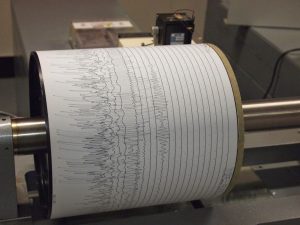
Signs of a 1755 earthquake that was strong enough to topple steeples and chimneys in Boston can be seen in a sediment core drawn from eastern Massachusetts’ Sluice Pond, according to a new report published in Seismological Research Letters.
Katrin Monecke of Wellesley College and her colleagues were able to identify a layer of light brown organic-rich mud within the core, deposited between 1740 and 1810, as a part of an underwater landslide, possibly unleashed by the 1755 Cape Ann earthquake.
The Cape Ann earthquake is the most damaging historic earthquake in New England. While its epicenter was probably located offshore in the Atlantic, the shaking was felt along the North American eastern seaboard from Nova Scotia to South Carolina. Based on contemporary descriptions of damage from Boston and nearby villages, the shaking has been classified at modified Mercalli intensities of “strong” to “very strong,” ((VI-VII) meaning that it would have caused slight to moderate damage of ordinary structures.
New England is located within a tectonic plate, so “it is not as seismically active as places like California, at an active tectonic plate margin,” said Monecke. “There are zones of weakness mid-plate in New England and you do build up tectonic stress here, you just don’t build it up at the same rate that would occur at a plate boundary.”
With few faults to study, however, researchers like Monecke and her colleagues are looking for signs of seismically-induced landslides or the deformation of soft soils to trace the historic and prehistoric record of earthquakes in the region.
Monecke hopes that the new Sluice Pond core will give seismologists a way “to calibrate the sedimentary record of earthquakes in regional lakes,” she said.
“It is important to see what an earthquake signature looks like in these sediments, so that we can start looking at deeper, older records in the region and then figure out whether 1755-type earthquakes take place for example, every 1000 years, or every 2000 years,” Monecke added.
The researchers chose Sluice Pond to look for signs of the Cape Ann earthquake for a variety of reasons. First, the lake is located within the area of greatest shaking from the 1755 event, “and we know from other studies of lakes that have been carried out elsewhere that you need intensities of approximately VII to cause any deformation within the lake sediments,” Monecke said.
Sluice Pond also has steep sides to its center basin, which would make it susceptible to landsliding or underwater sliding during an earthquake with significant shaking. The deep basin with a depth of close to 65 feet also harbored a relatively undisturbed accumulation of sediments for coring.
Through a painstaking analysis of sediment size and composition, pollen and plant material and even industrial contaminants, the research team was able to identify changes in sediment layers over time in the core. The light brown layer deposited at the time of the Cape Ann quake caught their eye, as it contained a coarser mix of sediments and a slightly different mix of plant microfossils.
“These were our main indicators that something had happened in the lake. We saw these near shore sediments and fragments of near-shore vegetation that appear to have been washed into the deep basin,” by strong shaking, said Monecke.
In an interesting twist, land clearing by early settlers from as far back as 1630 may have made the underwater slopes more susceptible to shaking, Monecke said. Sediment washed into the lake from cleared land loads up the underwater slopes and makes them more prone to failure during an earthquake, she noted.
For that reason, the sediment signature linked to prehistoric earthquakes may look a little different from that seen with the Cape Ann event, and Monecke and her colleagues are hoping to sample even older layers of New England lakes to continuing building their record of past earthquakes.
The research team is taking a closer look at a more famous New England body of water: Walden Pond. “It got slightly less ground shaking [than Sluice Pond] in 1755, but it might have been affected by a 1638 earthquake in southern New Hampshire,” Monecke explained. “We already have sediment cores from that lake, and now we are unraveling its sedimentary history and trying to get an age model there as well.”
Reference:
K. Monecke et al. The 1755 Cape Ann earthquake recorded in lake sediments of eastern New England: An interdisciplinary paleoseismic approach. Seismological Research Letters, 2018 DOI: 10.1785/0220170220
Note: The above post is reprinted from materials provided by Seismological Society of America.










